What is Tapestry Weaving?
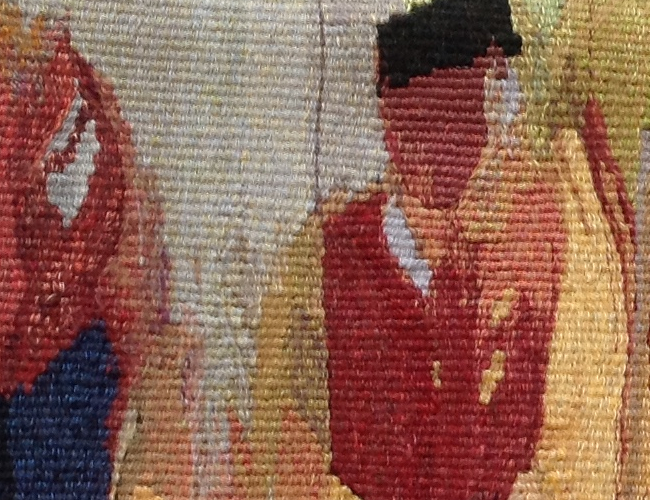 Estonian Dancers (detail) - Veronica Collins
Estonian Dancers (detail) - Veronica Collins
Tapestry is one of the oldest forms of woven textiles. The techniques used have remained the same for centuries. Remnants of tapestries woven in ancient Egypt have been dated as far back as 3000BC.
In the Middle Ages master weavers’ studios designed and wove great, colourful tapestries for wealthy clients. In the Renaissance artists such as Raphael were commissioned to produce cartoons for studios to copy, giving weavers less freedom of interpretation. Surviving tapestries from these times can still be seen, though they sometimes look rather dull and predominantly beige, blue and red. That’s because vibrant yellows, greens, purples and browns have disappeared as the dyes used have faded away.
Today, tapestry weaving is dominated by individual weavers producing their own designs, though a few studios where large tapestries are woven from artists’ cartoons still survive. Traditional fibres (wool, silk and linen) continue to be used, together with cotton and other more modern materials.
What defines a woven tapestry?
Woven tapestries are created by the interaction between warp and weft. The warp forms the 'backbone' of the fabric over which the weft is woven. A woven tapestry usually meets the following criteria:
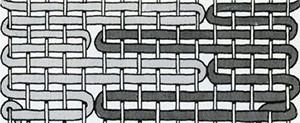 Tapestries are hand woven on a loom. Tapestry looms are either vertical (high warp) or horizontal (low warp).
Tapestries are hand woven on a loom. Tapestry looms are either vertical (high warp) or horizontal (low warp). - The design is formed by the weft (horizontal) threads, which are tightly packed to cover the warp (vertical) threads. The warp threads are normally completely covered so play no part in the design. This is known as 'weft facing'.
- Each colour of weft is worked only in its own section of the design, so there are many different wefts on the go at any one time. Unlike other types of weaving, it is rare for the weft to run across the entire width of the piece. This is known as 'discontinuous weft' as shown in the diagram.
- Tapestries are usually made to hang on a wall (though rugs, cushion covers and three-dimensional installations can also be made).
What is not a woven tapestry?
Fine woven tapestries take a long time to weave, so have long been rare and expensive. Perhaps because of this, the term ‘tapestry’ has been used for other techniques to produce pictorial textiles and wall hangings, often resembling woven tapestry but at a much lower cost.
|
Common examples are: |
What it is: |
|
‘Tapestry’ chair-backs, screens, cushions etc., including those sold in kit form |
Needlepoint, canvas-work, woolwork (a design is inked onto canvas or a similar fabric, then stitched with a needle to create the patterns and pictures) |
|
The 11th Century Bayeux ‘Tapestry’, The Quaker ‘Tapestry’ (completed 1989) and The Great ‘Tapestry’ of Scotland (completed in 2013) |
All of these are embroidered wall-hangings |
|
Jacquard weavings (eg Grayson Perry's 'tapestries'), which are often completely computer controlled, are a controversial issue for tapestry weavers. There are many differing opinions on whether they can be considered to be woven tapestries or not. |
They may not be handwoven (although some Jacquard looms allow the user to throw the shuttle by hand). In particular they do not meet the key criteria traditionally used in the definition of woven tapestry, especially ‘weft facing’ and 'discontinuous weft'. |
|
Large-scale ‘tapestry’ wall hangings and installations produced by various fibre-artists |
Can be a mix of any/all of (non-tapestry) weaving, threading, knotting, felting and embroidery |
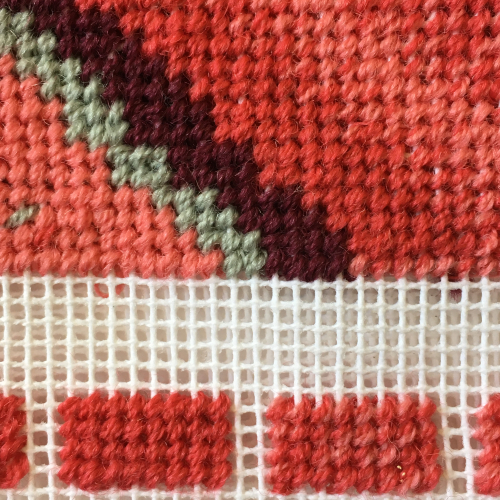 Needlepoint or canvas work
Needlepoint or canvas work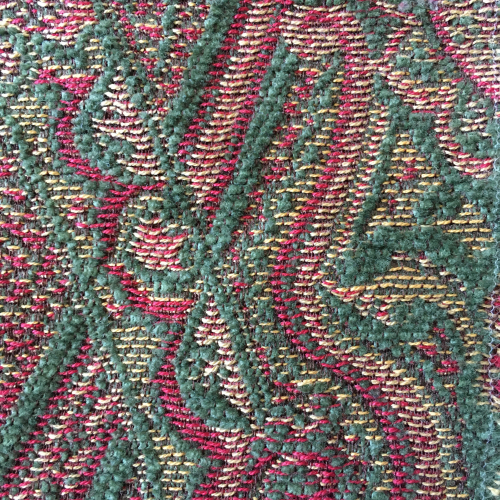 Jacquard weaving
Jacquard weaving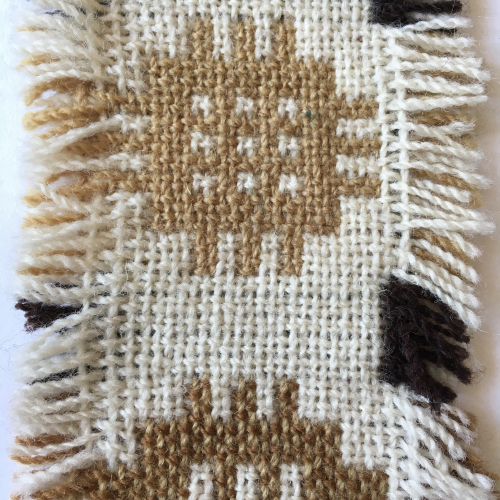 Welsh double cloth weaving
Welsh double cloth weaving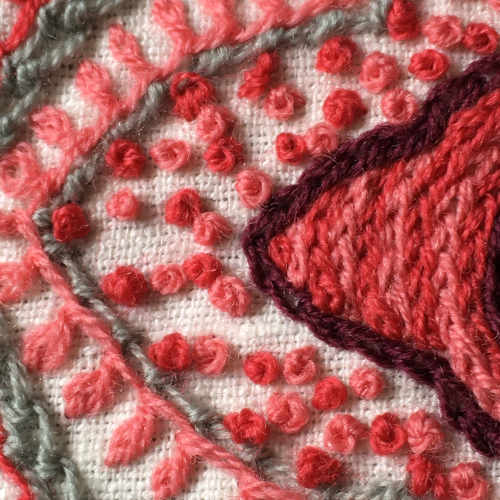 Crewel work embroidery
Crewel work embroideryImages and work by Claire Buckley
How to recognise a tapestry weaving
On any tapestry you’ll see characteristic lines of ridges where the weft threads go over the warp threads. This tells you it’s a genuine woven tapestry. During weaving, and sometimes when completed and hung, these lines of ridges run vertically from the top to the bottom of the tapestry - see Warp over Weft, below left.
But the lines of ridges may run horizontally - see The Wood (detail) below middle. This is because tapestries, especially large ones, are often woven so that the warps will be horizontal when hung. This distributes the weight of the tapestry better and prevents the wefts sliding down the warps with time (as happened with the Christ in Glory tapestry at Coventry Cathedral). When hung like this, the design has to be woven sideways on.
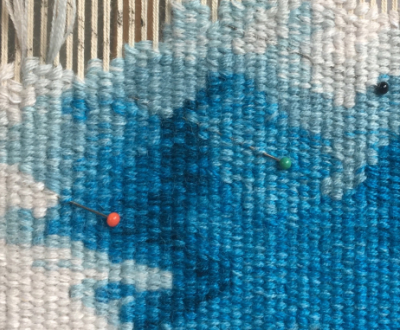 Warp over Weft - Julie Davies
Warp over Weft - Julie Davies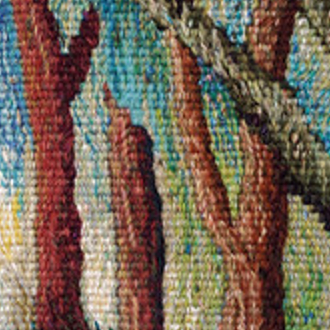 The Wood (detail) - Marianna Mele
The Wood (detail) - Marianna Mele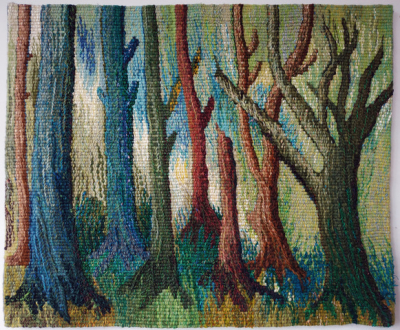 The Wood - Marianna Mele
The Wood - Marianna Mele
Where to see Tapestries in the UK
Here is a selection of places where tapestries can be seen – but there are many others:
Victoria and Albert Museum, London
The British Library, London
Hampton Court Palace, Surrey
William Morris Gallery, Walthamstow
Osterley House, Middlesex
Whitworth Art Gallery, University of Manchester
Hardwick Hall, Derbyshire
Birmingham Museum and Art Gallery, Birmingham
Coventry Cathedrals, Coventry
Tapestry Studio at West Dean College, Chichester
Knole House, Kent
Blickling Hall, Norfolk
Forde Abbey, Dorset
Montacute House, Somerset
Tyntesfield House, Somerset
Cotehele, Cornwall
Powis Castle, Wales
Anglesey Abbey, Cambridgeshire
National Museum of Scotland, Edinburgh
Dovecot Studios, Edinburgh
Glasgow Cathedral, Glasgow
The Burrell Collection, Glasgow
Falkland Palace, Cupar
Stirling Castle (seven newly-woven ‘Unicorn’ tapestries based on originals from early 1500s)
How to find out more
The information on this page is available as a pdf What is Tapestry Weaving?
You can see online galleries of past BTG exhibitions on our BTG Woven Art website.
In addition, artist weavers regularly hold their own exhibitions and open studios – see the What's New page for a current list of what’s going on across the country.
Want to find out more or try your hand at tapestry weaving? See the resources pages, which includes information on members who teach .
In addition, tapestry study days and workshops are held from time to time at museums and art galleries across the country. Local Guilds of Weavers, Spinners and Dyers may also have members who are interested in tapestry weaving and may run sessions on tapestry weaving from time to time. The complete list of AGWSD Guilds in the UK can be found at The Association of Guilds of Weavers, Spinners and Dyers website.

